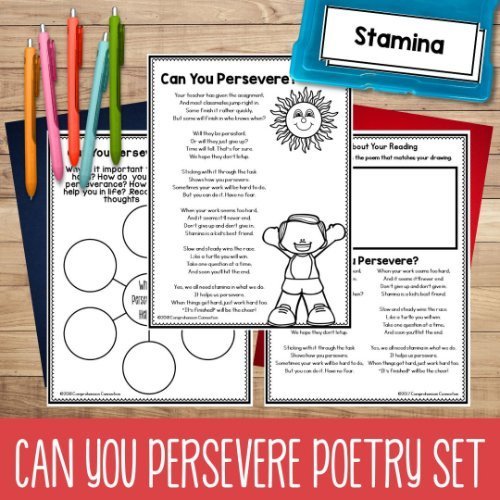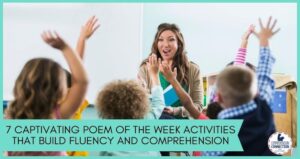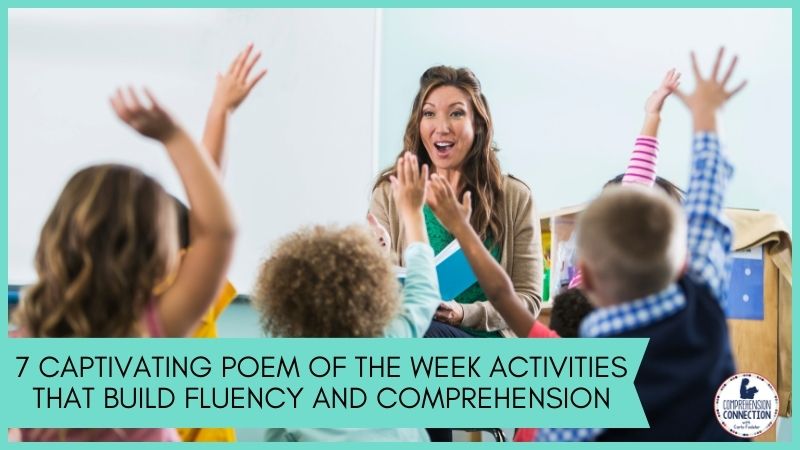
Using a poem of the week routine has been proven to be an effective way to build reading fluency, but it’s also useful for other skills as well. For years, I have implemented weekly poetry lessons, and I firmly believe that my students’ growth in reading stemmed from this powerful routine. In this post, I will be sharing activity ideas that not only benefit students who need a little support, but also those high flyers in your classroom.
Before I jump into my topic for the post, I do want to thank Susan for inviting me as a guest author on her website. I am Carla from Comprehension Connection, and Susan and I have known each other for years. I hope that you find the information I share helpful for your classroom, and after you read my post on poem of the week, I hope you’ll take a moment to hop over to my blog to read her post too.
The Benefits of Using Poem of the Week
Before we delve into poem of the week activity ideas, I want to share some of the benefits I’ve found with using poetry with reading lessons. Because poems typically fit on one page, students are able to stay engaged and maintain attention to the task. They aren’t bogged down by long passages or books, and teachers can utilize them in short blocks of time for big impact. Below are a few more benefits I’ve observed:
- Enhances Language Development: Poetry exposes all students to rich and varied language, expanding their vocabulary and helping them develop a deeper understanding. By selecting a variety of poems by different authors, you can match poems to readers. If you have students who need enrichment, challenge them with poems by Robert Frost, Langston Hughes, or Emily Dickenson.
- Improves Comprehension Skills: Analyzing poems encourages critical thinking and enhances comprehension skills as students interpret and analyze the meaning. The language usage is different from other genres, and therefore, it requires deeper thinking and comprehension of figurative language.
- Fosters Creativity: Poetry encourages creative expression, allowing students to explore their own thoughts, emotions, and ideas as they read poetry, but also as they write.
- Cultural Exploration: Poetry often reflects cultural perspectives, traditions, and historical contexts, providing a valuable avenue for students to explore diverse perspectives and broaden their cultural awareness.
- Develops Emotional Intelligence: Poetry frequently explores emotions and human experiences, helping students develop empathy and social-emotional skills as they connect with the sentiments expressed.
- Encourages Reflective Thinking: Poems often require readers to reflect on their own experiences and beliefs.
- Boosts Reading Fluency Skills: Even strong readers need practice at reading orally. Consider how often you speak publicly as an adult. Reading poetry aloud helps improve pronunciation, intonation, and oral communication skills, but it also fosters confidence in public speaking.
- Promotes Analytical Skills: Analyzing poetic elements such as rhyme, meter, and figurative language encourages students to develop strong analytical skills. It takes practice to identify figurative language such as metaphor, simile, idioms, hyperbole, etc. But students also need practice at understanding figurative language especially if they are concrete thinkers.
- Engages Striving Readers: As I mentioned initially, the brevity of poems are appealing to striving readers. They aren’t intimidated by the length of the task and find reading poetry lessons fun.
Introducing a Poem of the Week Routine
Step 1-Building Schema
When I begin poem of the week with my students, I start with a schema builder related to the themes in the poem. This hooks the students into the poem’s topic and builds background knowledge and vocabulary. You might do a word splash of themed words (think graffiti). It can be done whole group or in teams. Another idea would be to use an ABC brainstorm where students record words related to the topic. Finally, you can build in movement by having your students act out topic words for the class to guess.

Step 2 – Build Vocabulary
Once your students are engaged, the next step is to preteach key vocabulary or words that may cause your readers difficulty. I don’t spend a huge amount of time with vocabulary. I share the word, work on pronunciation, give the meaning and context for the word, and use it in a sentence. I use questioning with students to help them make connections to the words to give them context. As the week goes, students have ample exposure to the words in order for the new words to be added to their long-term memory.
Activities for Poem of the Week
Over the years, I have written poems for my students mainly because it took so long to find poems that tied to our books and themes. I have a poem of the week bundle that includes seasonal poems for grades 2-5 along with a set of cooking themed poems, sports themed poems, and my Building Poetry Pros set. I also have a newish collection of social-emotional poems on topics such as gratitude, kindness, respect, and empathy. These resources have saved me a lot of time because I can just print and go with them. Plus, the kids always thought it was special that I was the actual author.
During the year, one of the best things about poem of the week is the building of poetry anthologies. Students add new poems to their collections each week, so that by the end of the year, they leave with at least 50 pages of poems. I love this because it gives them summer reading material. Many of my students lacked access to the library or had books in their homes, but they always had their poems! Below, I’ll share some of the activities we enjoyed with poem of the week. However, you can also check out Susan’s posts, 3 Creative Ways for Teaching Poetry or How To Use Haiku Activities To Boost Student Creativity too.
Highlighter Hunts
You can play games like I Spy and X Marks the Spot to have your students work on specific vowel sounds or spelling patterns, but also vocabulary. You might ask your students to find a synonym for gigantic or friendly or loud. Highlighter hunts can also be used for finding heart words. This activity works well in small groups where you can have students mark the word(s) and pair/share to check answers.
Scoop the Phrase
Another fluency building activity I’ve used is to have students scoop phrases. To scoop the phrase, students simply place a bracket symbol like the example to the right from the beginning to end of the phrase. It takes a little practice to identify the phrases at first, but it makes a big difference for students who tend to “robot read”.
Another activity work on phrasing is to add a slash mark between phrases. Whether you scoop or add brackets depends on the spacing of the poem. Below is an example of using slash marks:
I’m the Dragon / of Grindly Grun. I breath fire / as hot / as the sun. When a knight / comes to fight, / I just toast him / on sight, / like a hot / crispy / cinnamon bun. ~Shel Silverstein

Color Code Text Evidence
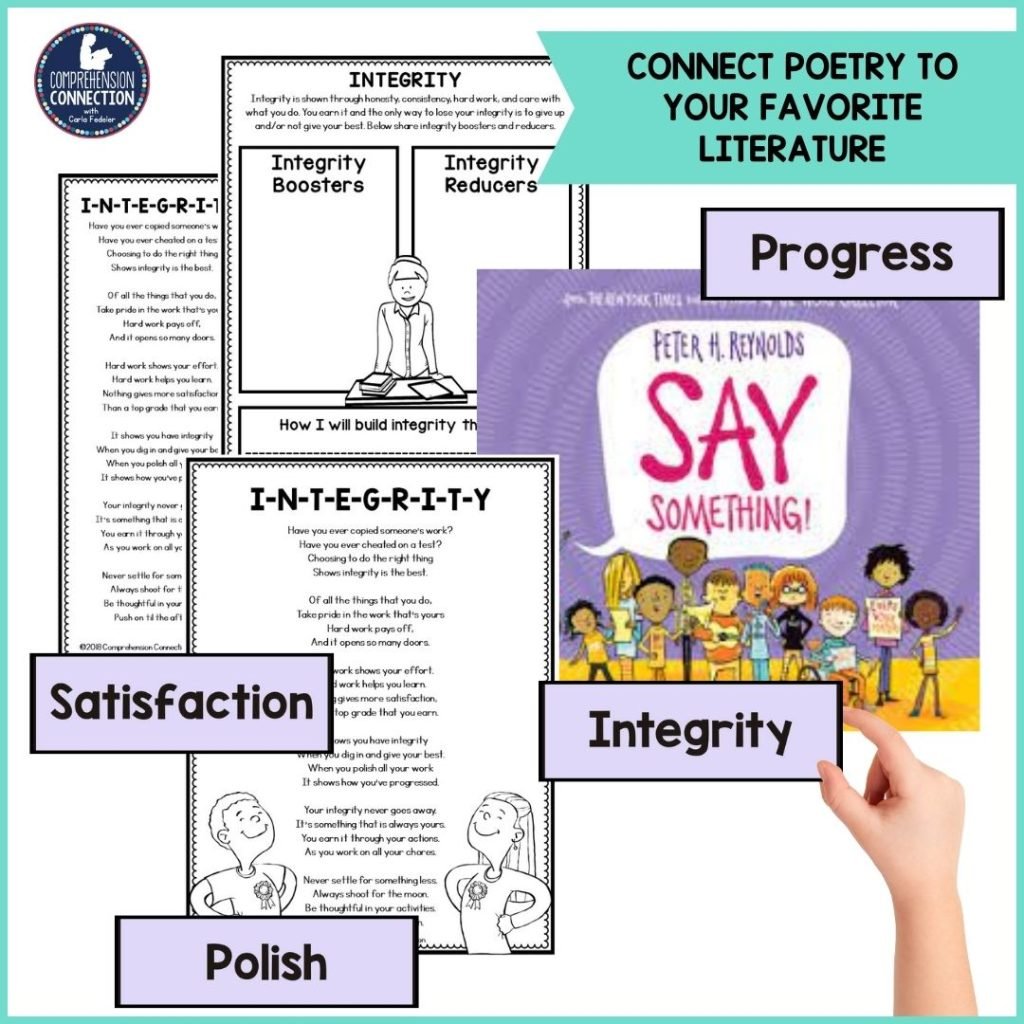
I am a firm believer in the importance of giving evidence for your thinking, and color coding the facts that support your responses is part of that. You can have students select a different color highlighter for each question posed. With questions on a worksheet, I have the kids circle in the number to show the color they are using for that questions’ text evidence. Color coding text evidence can be done with poem of the week just like it’s done with close reading.
One idea you might try is to share a related book and ask your students to mark text connections that relate to the literature. I often have my students write in the margins their connections.
Give this free poetry set on perseverance a try:
Radio Reading or Performing
One of the joys of poetry is reading it aloud. With radio reading, two partners work together to perform the poem. Each takes turns reading a verse. Students can record themselves “from the studio” and share the readings with their families. You can also do a single person performance too. If you want to take things a step further, after a few months of poem of the week, host a Coffee House Night for your families and let the kids perform as parents sip on coffee and snack on pastries.
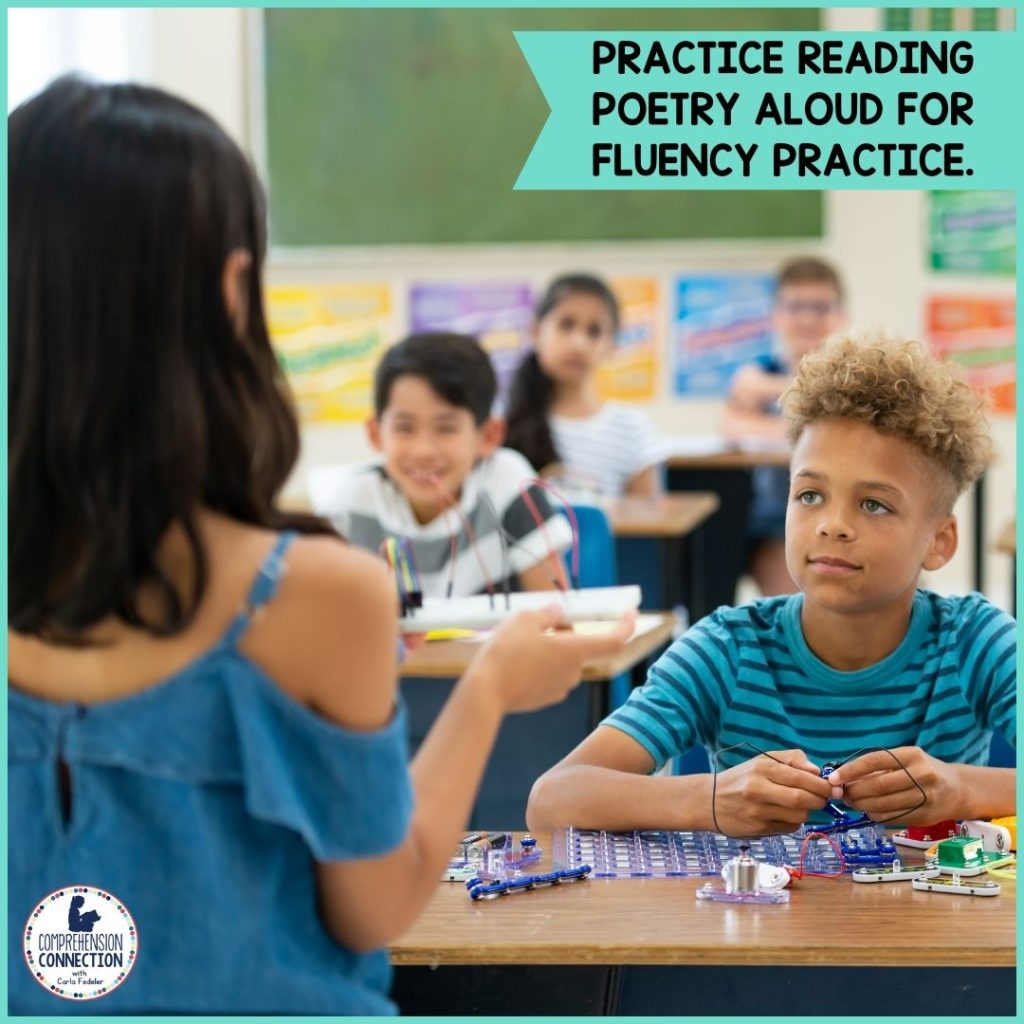
Build Language Skills by Learning About Figurative Language
We talked about figurative language studies as one of the benefits of using poetry with your students, and with my Building Poetry Pros set, you can use the anchor charts and graphic organizers with any poem you choose. It includes lessons on sensory words, idioms, similes and metaphors, and more.
With each of the figurative language examples, I project the anchor chart to explain the term and examples. With sensory words, students practice sorting them by sense which is very interactive. There are also graphic organizers geared to each type of figurative language that can be used with any poem you choose.
Ways to Work on Comprehension
Of course with every piece of text we use, comprehension needs to be addressed. Comprehension with poetry isn’t necessarily an easy task especially if there is a lot of figurative language used. For some students, this is a roadblock that must be addressed first. For comprehension, you might try printing the list of questions below. They can be used with any poem you choose.
- What is the central theme of the poem?
- How does the title of the poem relate to its content?
- What emotions or moods does the poem evoke, and how are they achieved?
- Can you identify any figurative language or literary devices used in the poem (metaphors, similes, personification, etc.)?
- How does the poet use imagery to create vivid mental pictures for the reader?
- Who is the speaker in the poem, and what do you know about their perspective or point of view?
- How does the structure of the poem contribute to its overall meaning or impact? (Consider rhyme scheme, stanza length, etc.)
- What is the tone of the poem, and how does it affect your interpretation?
- Are there any recurring motifs or symbols in the poem, and what do they represent?
- How does the poet use sound and rhythm to enhance the meaning of the poem?
- What cultural or historical context might be important for understanding the poem?
- How does the poem make use of language to convey its message or explore its themes?
- What is the intended audience of the poem, and how might that influence its style and content?
- Can you identify any allusions or references to other works or events within the poem?
- Do you think the poem is open to multiple interpretations, or is the meaning more straightforward?
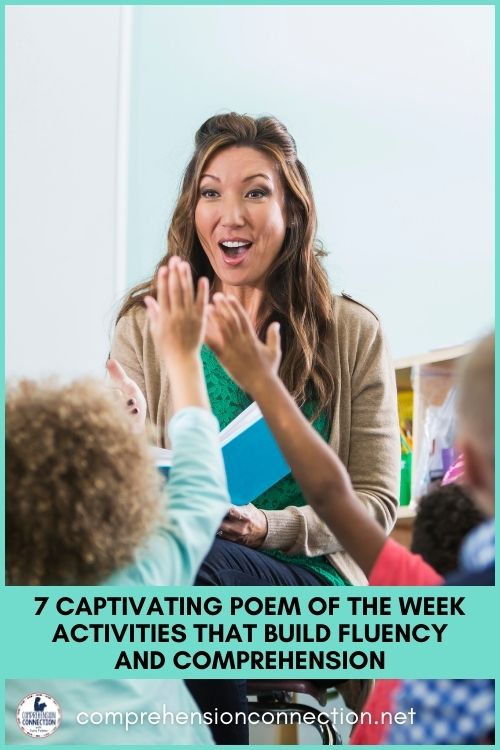
Writing Extension
The final suggestion I have for using poem of the week is to encourage writing. With poetry writing, you can work on types of poetry such as Haiku, Acrostic, or Cinquain poems, but you can also write about author’s craft, sensory words that help the reader visualize the poem, or prompts related to the poem’s theme. You might also tie your poetry to science and social studies content in order to extend a concept too. I firmly believe that writing naturally differentiates, and considering that this post is on a site for high achievers, I hope that you concur.
Would you like to win a copy of my SEL Poetry Bundle?
If you have made it to the end of this post, then I have one more thing to share with you. Susan and I have teamed up with 8 other literacy bloggers for an event we’re calling Trading Spaces (remember that show?) Well, we wanted to host a giveaway with this event to share with one lucky winner a $100 TPT gift card plus a copy of each resource we featured in our posts for a prize package valued at about $200. My free resource is my Perseverance Poetry Will the lucky winner be you? Follow our stores for the best chance to win. We’ll notify the winner February 11th. Good luck!


You are invited to the Inlinkz link party!
Click here to enter
Carla is a licensed reading specialists and author of Comprehension Connection. She has been sharing literacy tips and resources through her site since 2012. You can find her resources either in her website shop or on Teachers Pay Teachers. For other poetry related blog posts on her site, check the links below.

